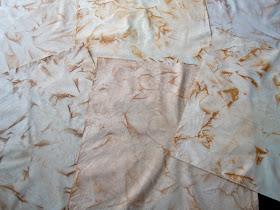The longer I have been teaching I have found that my students have the best class experience when I bring fabric for them to use. There are two primary reasons for this, one is if the fabric needs to be pre-colored with paint or dye as part of the process, there is just not enough time in a 6 hour workshop to accomplish this. The second reason is, there are a variety of different weaves in pfd cottons and for many of the techniques I teach, a smooth, light weight, tight weave fabric, like cotton sheeting, works best and not everyone has access to buying that locally.
For the Tea & Ephemera class, everyone begins with a peice of mottled brown fabric that has been colored with a diluted textile paint solution.
I like to create a variety of browns, reminiscent of tea stained fabric and used tea bags.
To make this fabric, I mix watery solutions of textile paint, this is a great way to use up the remainders of paint left in the jar. I make several browns, one of my favorite colors is made by combining buttercup yellow and purple, it's a gorgeous warm ochre brown.
I crumple peices of dry white pfd cotton fabric and dunk it in the paint solution.
Then I squeeze out the fabric
and lay it on the table, partially crumpled, to dry. As it dries the pigment in the paint is drawn to the creases in the fabric.
After it has dried, I iron the fabric to reveal all the beautiful texture.
I've prepared tea fabric for half the classes I am teaching this year, later this week I will do another big batch to finish the rest. Then it's time to prep for the next class...
Tweet









Thanks for the peek into how you do it! you rock Judy!
ReplyDeleteBeautiful! May I ask specifically what kind of paint you're using? Thanks.
ReplyDeleteThanks Natalya!
ReplyDeleteMiss T, I use setacolor textile paint mostly but will occasionally add some Jacquard as well.
I really like the colour patterns with this method. I've had some quite good results with ordinary artists' acrylics as well as with textile paints. If the colours are diluted enough, it doesn't seem to change the hand of the fabric, and it doesn't need heat setting. Such a great idea to provide fabric at the start of a class, too.
ReplyDeleteI use rit dyes and make my own tea mud, prefer that to using tea. I think in a class, most would prefer the fabrics ready to use, so they can enjoy the process of creating.
ReplyDeleteDebbie
Thanks for showing us how you get that beautiful texture. I agree that it's a great idea to have the prepared fabric provided in a class...more time to create!
ReplyDeleteCool photo with the crumpled fabric! And to think, this time last year you were packing your bags to come to New Zealand! Got to make some Anzac biscuits, that day is fast approaching!
ReplyDeleteHi Erilyn,
ReplyDeleteOh how I wish I were packing my bags to fly to New Zealand right now! Yum I want an Anzac biscuit!
I hope your students appreciate the trouble you take!
ReplyDeleteAs a student, I like having "the right materials" -- so much easier for me when there's a kit.....
Thank you.
Beautiful fabrics! But, no gloves? Do your hands go brown from the paint?
ReplyDeleteHi Lisa, no gloves for me, paint washes off pretty well, it doesn't stain like dye does. I usually keep a large container close by (you can see the white bucket on the table) for adding more water when mixing paint, so I occasionally will dip my hands in there to give them a rinse if I need to.
ReplyDeleteI love this idea. I have wondered many times what to do with all my left over paint. The fabric looks great and no wastage. Thanks for the great tip.
ReplyDeletehttp://catherineparkinson.blogspot.com
Thanks, Judy!
ReplyDeleteJudy! Check out my blog - there's something there for you :-)
ReplyDelete